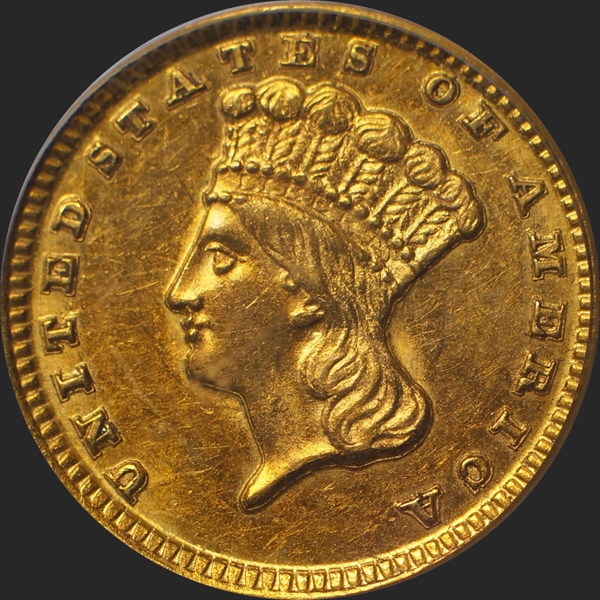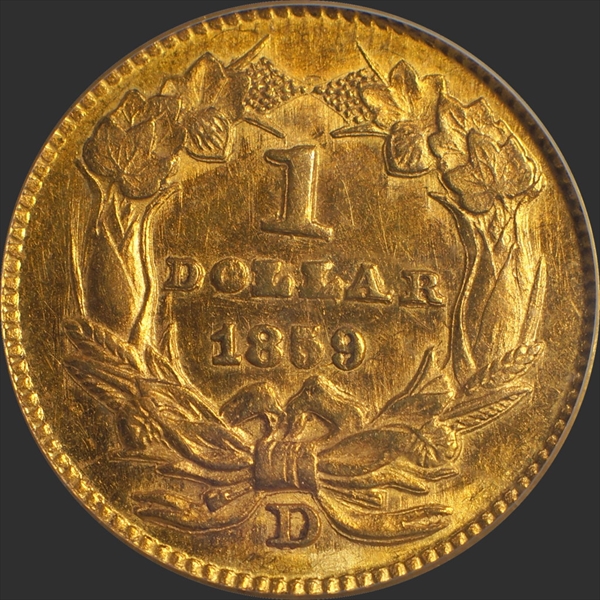1859-D G$1 AU58 认证号21823175, PCGS号7553
拥有者评论
Mintage: 4,952. Indian Princess (Large Head) The design blunder by Longacre brought about the immediate redesign of the gold dollar once again in 1856. An improvement, but incomplete strikes still evident at branch mints. This example has bright yellow golden toning with only trace of wear. Near full strike, nice frosty luster, and eye appeal. A rare issue in AU58. Total coins known 150-175.
专家评论
David Akers (1975/88)
The data gained from the auction records does not clearly indicate this, but in my experience, the 1859-D is the most common D Mint Type III gold dollar with respect to both the total number of specimens available, and the number obtainable in high grade. For example, I have seen significantly more 1859-D's than I have 1858-D's, and I have seen many more choice examples as well. Nevertheless, the 1859-D is a very scarce coin, and a collector must be willing to accept one that is poorly struck since that is essentially the only way the 1859-D comes. oO most specimens, the 8 and the 5 in the date are very weak.Doug Winter
The 1859-D is the most common Dahlonega Type Three gold dollar. It is one of the more readily available gold dollars from this mint, although it is much scarcer than the 1849-D.The 1859-D is the most common Type Three Dahlonega gold dollar and it can easily be found in the lower circulated grades. It is relatively available in the lowest About Uncirculated grades but it becomes rare in the higher About Uncirculated grades. Mint State 1859-D gold dollars are rare but this is the most available Type Three Dahlonega gold dollar in Uncirculated.
STRIKE: The 1859-D is probably the best struck of the six Type Three Dahlonega gold dollars. This is not saying much as these are among the worst stuck group in all of American numismatics. The obverse shows slightly above average detail. There is weakness on the plumes and the hair of Liberty but some are comparably well detailed in these areas. The lettering is thick and shows pronounced doubling. The individual letters are usually sharp although some coins show weakness on the IC in AMERICA. The date is rarely full and examples exist on which the 5 is very faint. On others, the first three digits are weakly impressed. The OLL in DOLLAR is heavily filled and some show blurriness on these letters. The weakest area on the reverse is usually the bow and the knot and this can be very faint. The milling is distinct and well detailed although it is weak below the head.
SURFACES: This date comes with better surfaces than the 1857-D or 1858-D gold dollars. However, it is very common to find an 1859-D which shows mint-made planchet defects. Others have planchet chips, areas of roughness or lintmarks. There are centrally located clashmarks on many as well.
LUSTER: The quality of luster on high grade 1859-D gold dollars is generally below average. The luster is dull and somewhat grainy. A few are known which show good frosty luster.
COLORATION: Uncleaned, original examples have coloration ranging from orange-gold to green-gold. Most are at the lighter end of the spectrum. It is much more difficult to find an 1859-D gold dollar with original color than is commonly realized, due to the large number that have been cleaned or dipped in recent years.
EYE APPEAL: The level of eye appeal is generally below average. This is primarily the result of strike but it is also due to the fact that many have been cleaned and others were struck on inferior quality planchets.
DIE VARIETIES: Two die varieties are known.
Variety 11-N: The lettering on the obverse is not as thick as on the 1857-D and 1858-D gold dollars and none of the letters are totally filled or closed. The date is low and level and positioned somewhat to the left with the 9 under the left foot of the A in DOLLAR. The mintmark is large and placed high with its location somewhat to the right. It tilts slightly upwards and it nearly touches the right ribbon end. There are noticeable die file lines to the left of the wreath.
Variety 11-O: The data is lower than on Variety 11-N and it slants slightly up to the right. The 9 is centered under the A in DOLLAR. The mintmark is large and high but a bit better centered than on the other variety. There are very heavy extra outlines on the upper portion of the wreath.
PCGS #
7553
设计师
James Barton Longacre
边缘
Reeded
直径
14.30 毫米
重量
1.70 克
铸币数量
4952
金属成分
90% Gold, 10% Copper
更高评级数量
33
评级较低的钱币数量
89
地区
The United States of America
价格指南
PCGS 数量报告
拍卖 - PCGS 评级的
拍卖 - NGC 评级的
稀有性和存量估计 了解更多
| 所有评级 | 200 |
| 60或以上 | 20 |
| 65或以上 | 0 |
| 所有评级 | R-7.0 |
| 60或以上 | R-9.1 |
| 65或以上 | R-10.1 |
| 所有评级 | 19 / 49 TIE |
| 60或以上 | 11 / 49 TIE |
| 65或以上 | 1 / 49 |
| 所有评级 | 31 / 81 TIE |
| 60或以上 | 22 / 81 TIE |
| 65或以上 | 1 / 81 |
状况普查 了解更多
| #1 MS64 PCGS grade |
| #1 MS64 estimated grade |
| #3 MS63 PCGS grade |
| #3 MS63 PCGS grade |
|
#3 MS63 estimated grade
"Longfellow" collection Heritage auction February, 2010 lot 1415
|





















